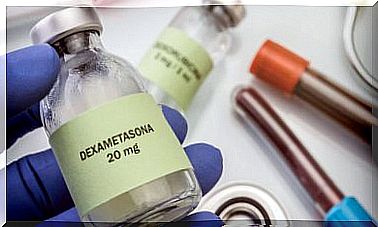Shellfish Allergy: Symptoms, Complications And Treatment
Shellfish allergy is not that uncommon in the population. Mollusks and crustaceans are susceptible to triggering autoimmune hypersensitivity reactions, becoming severe in some cases. For this reason, it is important to identify if such a process exists to avoid major complications.
Remember that the allergy is caused by a reaction of the immune system. A protein is recognized as a harmful agent, even if it is not. From here on, a disproportionate reaction can take place which, if it evolves, compromises the person’s life.
What is a shellfish allergy?
This allergy is caused by the entry into the body of proteins from certain seafood, as evidenced by a study published in Current Opinion in Allergy and Clinical Immunology . Among them, the most susceptible to triggering an allergy are crustaceans and mollusks.
The moment the body detects this antigen, it generates an inflammatory defense reaction that, on occasions, can be complicated by causing serious damage. The least desired outcome is anaphylaxis.
Among the risk factors for the development of an allergy of this type, family history stands out. In addition, adults are more prone than children, although it can occur at any time in life. Likewise, this problem is relatively more frequent in women.

what are the signs and symptoms?
Shellfish allergy symptoms can be mild or severe. In general, the signs begin to appear an hour after ingestion. It is common to have some swelling of the lips or tongue, as well as itching.
In the most severe cases, shortness of breath and intestinal problems develop, such as diarrhea, abdominal pain, and vomiting. In these types of situations, medication is usually necessary, as well as the administration of a probiotic, which has proven to be effective in controlling diarrheal episodes.
Dizziness, lightheadedness and even fainting or loss of consciousness can also occur. If these signs occur, surveillance by a health professional will be necessary, as well as pharmacological intervention.
Anaphylaxis
Shellfish allergy is susceptible to developing a severe adverse reaction known as anaphylaxis . This can be fatal and requires immediate medical action. In fact, the emergency treatment is the injection of adrenaline, as confirmed by a study published in Jornal de Pediatria .
Symptoms of anaphylaxis include severe throat swelling that makes it impossible to breathe, a sharp drop in blood pressure, and dizziness that can lead to fainting or loss of consciousness. It should be noted that, without the help of epinephrine, these kinds of situations cause death.
Shellfish allergy complications
There are certain situations that increase the propensity to develop anaphylactic shock. If you have asthma, a family history of food-induced anaphylaxis, or a small amount of shellfish triggers an allergic reaction, the hypersensitivity process may be complicated.
For this reason, it is crucial that you avoid the consumption of such foods and that you look at the labels of the products you buy. In this way, you can ensure that they do not contain traces of elements that can be harmful to health.
Also, you may need to avoid places where seafood is processed. The vapors emitted during cooking could trigger an adverse reaction.
How to treat a shellfish allergy?
At present, there are no known treatments to cure shellfish allergy. It is a process that, once it appears, lasts a lifetime.
For this reason, the only thing that can be done in this regard is to completely avoid the ingestion of these marine foods, as well as the inhalation of the vapors that they give off. This applies, of course, for those with a confirmed allergy.
If you go to a restaurant, make sure there is an allergen statement on the menu. In this way, you will know which recipes are likely to contain seafood among their ingredients to avoid them completely.
Also be careful with products packaged and formed from fish proteins, such as surimi. Sometimes they contain traces of shellfish, which is harmful to allergy sufferers.
Shellfish allergy in children
We have already highlighted that it is more common to develop a shellfish allergy during adulthood than in childhood, although the latter is also possible. If a minor is detected such a process, it is advisable to always have a dose of epinephrine on hand in case of an emergency. This can prevent a life-threatening anaphylactic shock.
The child’s caregivers must also know that they have an allergy to this type of food so that they avoid contact with possible allergens. At the same time, if the minor begins to develop symptoms of a hypersensitivity process, such as swelling, itching or inflammation of the mouth, it is advisable to always go to the emergency room.
Prevention tips
In the case of shellfish allergy, it is important to take into account a series of prevention tips.
Read labels
Ensuring that grocery store products are allergen-free can be done by looking at the labels. In this way, many later problems are avoided.
Be careful when eating out
In the menu of the restaurants the allergens of the dish are usually reflected. In any case, it is a good idea to always advise the waiter so that they take special precaution with cross contamination.

Cross contamination
It is common for those allergic to shellfish to develop hypersensitivity if shellfish are cooked in the same container with a different food. It is not necessary to ingest the mollusk as such to reach ampilaxis; sometimes it is enough that their antigens are present in a container or culinary utensil. Therefore, hygiene is essential.
Shellfish allergy is a food problem
As you have seen, a shellfish allergy can put a person’s life at risk if a series of precautions are not taken in this regard. For this reason, it is always important to read the labels and go to the doctor if you suspect that you may have a process of hypersensitivity to this kind of food.
If your fears are confirmed, remember to get a dose of epinephrine in case you ever need to use it. This applies to parents and caregivers of children with the disorder, who must also be vigilant and try to keep it away from contact with allergic substances.









